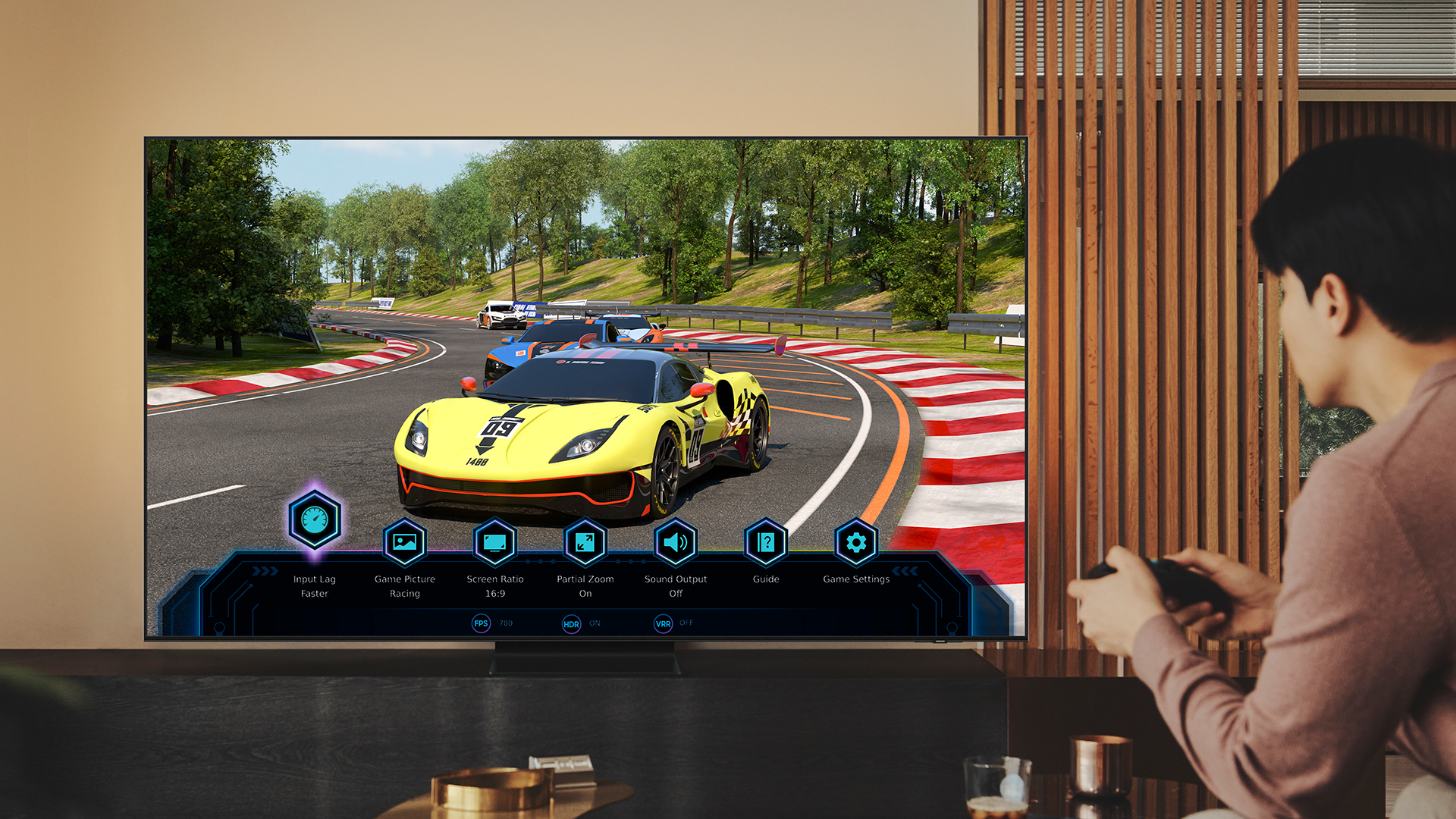Samsung QN90B vs QN90A: elite QLED 4K TVs compared
What has Samsung upgraded in this year’s QN90B 4K TV compared to the QN90A from last year? We break down the differences


If you’re looking at a killer Samsung TV upgrade, you might be wondering about the Samsung QN90B vs the Samsung QN90A – the QN90B is the 2022 version of Samsung’s high-end 4K TV, while the QN90A is the model from 2021.
At the time of writing, the Samsung QN90B has just launched, but the QN90A is also still on sale… and for a lot less money than the QN90B, due to price reductions over its life. Both rank extremely highly among the best Samsung TVs, but if you’re looking to buy today, you probably want to know what upgrades the new version brings before you make your decision. And that’s what this guide is for.
While Samsung wasn’t the first brand to launch a TV using mini-LED technology, in 2021 it certainly became (alongside rival LG) the first brand to really go big on it, using the term Neo QLED for its version of the technology. The premium QN90A 4K TVs were sensational, as the far higher number of much smaller LEDs used to illuminate mini-LED screens delivered unprecedented levels of light control by LCD standards. Contrast, colour, dark scenes, bright highlights… all these key parts of picture quality benefitted hugely from Samsung’s mini-LED move.
And the QN90A also hit a serious sweet spot for pricing, by offering essentially the same image quality as the even more expensive Samsung QN95A, but trimming some other features to make it much more affordable.
This year, the QN90B does exactly the same thing – we’ve already said in our Samsung QN95B review that its image quality is effectively unparalleled, and the QN90B brings much of that tech at a lower price.
Both the QN90B and QN90A are among the best TVs available today, but let’s go through all the differences, to help you decide which is best for you.
Samsung QN90B vs QN90A: Price and sizes
In 2021 Samsung launched no less than six QN90A models, ranging in size from just 43 inches all the way up to a monster 98 inches, and with 50, 55, 65 and 75 inch models filling in the gaps.
Get all the latest news, reviews, deals and buying guides on gorgeous tech, home and active products from the T3 experts
The QN90B range also includes six models, but tops out at 85 inches rather than 98. The other five QN90B screen sizes match those of the QN90A range.
The official prices for the Samsung QN90B are: 43-inch £1,299 (US release TBC); 50-inch £1,499/$1,599; 55-inch $1,899/£1,899; 65-inch £2,699/$2,599; 75-inch £3999/$3,499; 85-inch £5,499/$4,999.
The official prices for the Samsung QN90A at the time of writing are: 43-inch £899/$899; 50-inch £999/$1,199/; 55-inch £1,199/$1,249/; 65-inch £1,599/$1,749; 75-inch £2,499/$2,599; 98-inch £17,999/$14,999.
So there's a huge difference, but that's normal when comparing a TV that's been out for a year with one that's just arriving – but it does mean that it's certainly no slam dunk to choose the QN90B for its upgraded when the QN90A is fantastic and so much cheaper… while stocks last. You can find the current lowest prices for the Samsung QN90A below.
Samsung QN90B vs QN90A: Picture quality
The QN90B and QN90A both feature Neo QLED mini-LED technology – and when it comes to the most fundamental elements of this technology, both screens use the same sort of mini-LED ‘structure’ and similar numbers of backlight local dimming zones.
Some may feel a little disappointed by this – especially the apparent failure to substantially increase the number of dimming zones. We’ve seen plenty of evidence with premium ‘regular’ (not mini-) LED TVs, though, to know that it’s not always the number of dimming zones that counts; it’s what you do with them. And on that front, the new Samsung QN90B has a very promising new feature to shout about: Shape Adaptive Light Control.
This widens or narrows the light intensity of each separate dimming zone as dictated by the picture being shown at any given moment. The idea being that the backlighting can illuminate images with much more finesse and local light subtlety, reducing the likelihood of clouding around stand-out bright objects and enabling bright objects to enjoy more crisply defined edges.
So it gives the appearance of the extra lighting precision that people want from having more dimming zones, and as we’ve already seen in our Samsung QN95B review, it’s highly effective.
Backing the Shape Adaptive Light Control up on the QN90B is an upgrade (on the 55-inch and bigger models) from 12-bit to 14-bit management of the TVs’ backlight performance. While this doesn’t mean the screen can handle 14-bit sources (even if they existed), it does mean that the QN90B is able to deliver more subtle shading in dark areas and more finesse in HDR colour blends. It essentially means that the TV can more precisely control exactly what level of brightness or dimness is required from each backlight dimming zone.
Both of these potentially significant new picture advantages are powered by an even more powerful version of Samsung’s AI-based picture analysis/processing system. This is able to draw on the accumulated picture analysis knowledge of a massive 20 neural networks versus the 16 deployed for the QN90A, delivering even more accurate, effective and natural enhancements to every image.
One final new picture-boosting tool sported by the QN90B is the innovative new Smart Calibration system. This enables anyone with a reasonably recent Samsung Galaxy or iPhone to use its camera in conjunction with an app and test signals output by the TV to automatically calibrate pictures to the industry standards. The auto-cal system lets you either run a quick calibration that only takes a few seconds, or a much longer calibration that takes a few minutes but ends up with much more accurate results. All without having to spend the hundreds of pounds charged by professional calibrators.

The design of the QN90A and QN90B is pretty much identical – a thin overall frame, with a single stand in the centre.
Samsung QN90B vs Samsung QN90A: Sound Quality
Both the QN90B and QN90A sport Samsung’s Object Tracking Sound (OTS) technology. This uses speakers ranged right around the TVs’ frames and clever processing to make sound effects appear to be emanating from the correct area of the screen.
The QN90B builds on this, though, with a new Human Tracking Sound element that utilises the image analysis abilities of its AI-based processing to detect where faces are appearing and then position the sound of anything those faces might say more accurately.
Even better, Samsung has also finally brought Dolby Atmos sound support to its 2022 QN90 range. The object-based approach to sound stage building delivered by Dolby Atmos has long struck us as a natural fit for Samsung’s OTS technology, and it’s a natural fit in real life, adding even more precision and clarity to where the sound is coming from. Dolby Atmos support is also very welcome if you’re going to add one of the best soundbars for Samsung TVs too, of course.

Both Samsung TVs offer great features for gamers.
Samsung QN90B vs Samsung QN90A: Design and Features
With their robust, centrally mounted metal desktop stands, exceptionally slim screen frames, silver metallic outer trims and monolithic design approaches (where the rear sides look as flat as their screen sides) the QN90B and QN90A adopt a pretty similar design approach. Both ship with a cool solar-powered ‘smart’ remote control, too.
When it comes to new features beyond the picture and sound advances we’ve already covered, the headline grabbers are a new look for Samsung’s Tizen-based smart interface, and a few new tricks aimed at gamers.
The QN90B Tizen interface shifts to a full-screen presentation from the much more economical look of the QN90A, which only takes over around a third of the screen. The QN90A’s relatively minimal approach enables you to keep watching TV for the whole time you’re browsing the smart menus, whereas the new Tizen interface only lets you keep watching (in a fairly small box) what was on when you hit the Home menu button until you navigate away to a different area of the menus.
Full-screen smart interfaces can tend to look rather confusing and overwhelming compared with more compact systems, too – and that’s proved to be the case here, based on our experience. It’s the only thing in the QN90B that feels like a step back from its predecessor.
On the gaming front, the QN90B offers an improved version of the Game Bar interface that appeared on the QN90A. This will provide gamers with a fuller combination of information on the game graphics being received, and more options for enhancing the gaming experience. These include new Preset modes specifically designed to enhance FPS, RPG, RTS and Sports game genres, and options for sacrificing a little response time speed in return for improved picture quality with games that aren’t built around response speed.
Samsung QN90B vs Samsung QN90A: Conclusion
While the QN90B’s advances over the QN90A might not earn it as many headlines as its predecessor, its picture improvements are targeted and effective. The addition of Dolby Atmos to the QN90B’s audio talents, too, brings it more in line in audio terms with most premium TV rivals.
The shift in approach for the QN90B’s smart TV features don’t play out in the QN90B’s favour, but in every other way it’s a clear step up over its predecessor. However, it will all come down to price – it’s an undoubtedly expensive TV overall, and the QN90A is now something of a bargain, while it lasts. No one would pay the QN90A’s prices and come away unhappy – it’s just a question of whether you’d be even more happy investing in the QN90B’s upgrades.
John Archer has been testing TVs and AV gear for over 25 years, having worked on Home Cinema Choice magazine. He's a contributor to Forbes, TechRadar, Trusted Reviews, Wired and many more places – if you've owned a TV in the last couple of decades, John's probably reviewed it somewhere. He's seen so many hot new technologies come and go, like tears in the rain.
